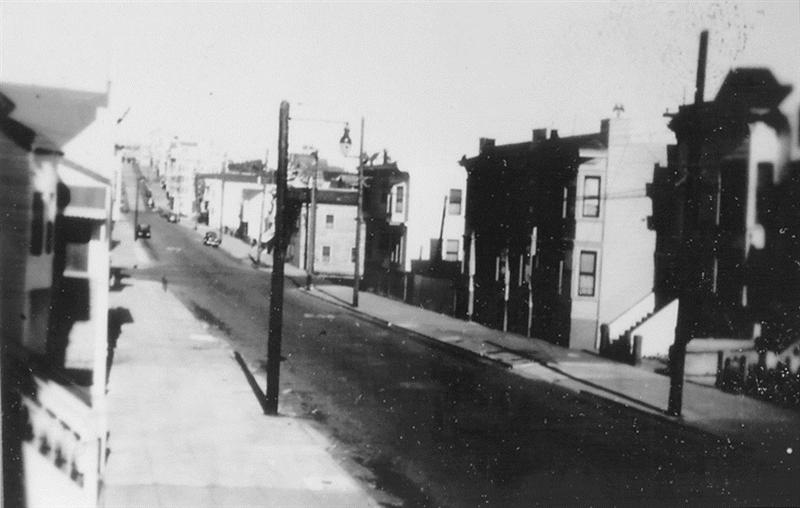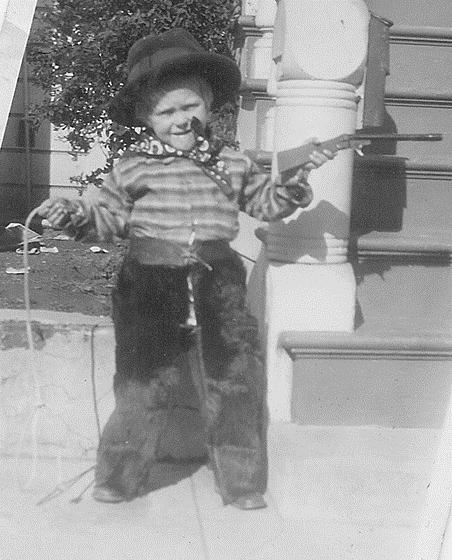
RETURN TO HOME PAGE
FEEDBACK
 |
February 2011 RETURN TO HOME PAGE FEEDBACK |
By Fred Lossman

In 1937, when this photo was taken, Jersey Street (looking east from Noe) had so little traffic kids could skateboard and play ball to their heart’s content. Photos courtesy Fred Lossman
Editor’s Note: Not too long ago, Nevada City (Calif.) resident Fred Lossman sent us a collection of reminiscences he had written for his family. Lossman, 76, was born and raised in Noe Valley, in a house on Jersey Street his parents bought in 1923. His memoir recalls his grade-school days and the fun he and his pals had scampering through the streets of the neighborhood. Read on and you may find a new use for your front steps.
I recently explored the streets of my little town of Nevada City. It was a bright sunny afternoon in the middle of the week after children had returned home from school. I was amazed that I did not see a single child playing outside—not one.
What a dramatic contrast to my memories as a child playing in the Noe Valley. In the 1930s and ’40s, there were no Little Leagues, no preschools, and few parent-attended athletic events for children. We were left to our own devices to learn to play. We also had to learn to resolve our own disputes.
We played on the sidewalks and the streets both during the day and in the evening. Automobiles were only a minor inconvenience to us. We were able to play catch, baseball, soccer, and touch tackle on the streets, with only rare interruptions from annoying cars.
I was always anxious to go out and play after school. I recall each day running the last couple of blocks to get home as soon as possible. The first words from Mom, after greeting me, were instructions to change my clothes before going outside. I’d throw on a T-shirt and a pair of rumpled pants and race out the door. There were always neighborhood kids gathered outside waiting to play.

When he wasn’t stirring up dust as a cowboy, Fred’s brother Ted was learning the ropes of hide-and-seek on city streets. “Olly, olly oxen free!” was a familiar cry when we played hide-and-seek. The phrase probably came from “All the outs in free.” It was yelled as a signal to all the kids in hiding that they could safely come out into the open without being “it.” I can still walk the streets near 246 Jersey Street and point out some of our favorite hiding places.
The decisions regarding our play activities were usually age-related. Smaller kids would mark hopscotch diagrams on the sidewalk with chalk and play tag, jump-rope, or hide-and-seek.
The next step in our playing evolution involved toys with wheels. First, there were tricycles, then rollerskates, homemade skateboards and coasters, Flexi’s (similar to a sled, but with wheels), and, lastly, two-wheeled bikes.
The homemade skateboards and coasters were our first construction projects. We would use salvaged wagon or skate wheels, orange crates, ropes, and various other hardware. Scrap two-by-fours were used for skateboards or for axles on the coasters. On the coasters we’d nail oversized discarded shoes onto the axles and slip our feet into them as makeshift brakes. I still remember the thrill of running these contraptions down the neighborhood hills for the first time.
When we reached 8 or 9, we got serious about playing ball. “Anyone wanna play catch?” First, we’d simply throw the ball (usually a worn tennis ball) from one sidewalk to the opposite sidewalk, pausing only for the occasional passing car. If someone had a bat, we’d organize a baseball game. A manhole cover usually served as home plate. The bases were marked by someone’s jacket, an extra baseball mitt, or perhaps the fender of a parked car.
When most of the boys acquired or were able to borrow a real baseball, as well as mitts and bats, we would move to the paved play area at James Lick Junior High. Better yet, on Saturday mornings we’d hike up the hills to Douglass Park. At the school, it was common for the threads on the baseballs to become worn from hitting the pavement. Their covers would fall off. Then we’d wrap black electrician’s tape around them and continue to play.
Stair Baseball
If we couldn’t find enough players, we’d play stair baseball. This was best limited to two boys. The “batter” would stand about two feet away from the steps. The object was to throw the tennis ball at the point of the step where the riser meets the tread. We preferred terrazzo steps instead of wooden ones because the ball would bounce farther. Our favorite location was on Chattanooga Street, specifically the block between 24th and Jersey.
If it hit precisely, the ball would bounce over the head of the other player, usually positioned in the middle of the street. If the ball went over to the sidewalk across the street, it was a home run. I recall many skinned knuckles from colliding with the stucco sides of the buildings that lined the staircases. I also recall getting chased away by annoyed homeowners, who objected to the constant commotion on their steps.
As we moved through our teen years, football became the game of choice. First we played touch tackle on the streets or playgrounds. Soon this wasn’t challenging enough and we played tackle at Dolores Park. Some of us had pads and helmets, and some had to do without and take their chances. I recall vividly taking the long walk home from the park, muddy, battered...and happy.
Finding a “field” was a precious thing to a child in San Francisco at that time. Usually we had to make do with a 25-foot lot where either a house had been torn down or another was waiting to be built.
But we did have the slopes of Twin Peaks before it was covered with buildings. And closer to home, we also had the field beyond Douglass Street, a rolling grassland reaching all the way to upper Market Street. This was before the 1947 grading and construction of upper Clipper Street. All these changes ended the many hours I spent with my Daisy BB gun, wandering through the grass-covered slopes pretending I was a big-game hunter.
Playing in the streets and in the hills and valleys of the neighborhood was a boy’s rite of passage in the San Francisco of the ’30s and ’40s. It took a two-wheeled Schwinn bike to advance us kids to the next stage of our development.
You can share stories with Fred Lossman at Lossman34@sbcglobal.net.